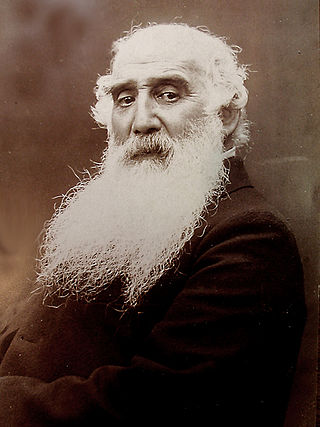
Jacob Abraham Camille Pissarro was a Danish-French Impressionist and Neo-Impressionist painter born on the island of St Thomas. His importance resides in his contributions to both Impressionism and Post-Impressionism. Pissarro studied from great forerunners, including Gustave Courbet and Jean-Baptiste-Camille Corot. He later studied and worked alongside Georges Seurat and Paul Signac when he took on the Neo-Impressionist style at the age of 54.

Charles-François Daubigny was a French painter, one of the members of the Barbizon school, and is considered an important precursor of impressionism.

Auvers-sur-Oise is a commune in the department of Val-d'Oise, on the northwestern outskirts of Paris, France. It is located 27.2 km (16.9 mi) from the centre of Paris. It is associated with several famous artists, the most prominent being Vincent van Gogh. This was also the place where Vincent van Gogh died, apparently by suicide.

Paul-Ferdinand Gachet was a French physician most famous for treating the painter Vincent van Gogh during his last weeks in Auvers-sur-Oise. Gachet was a great supporter of artists and the Impressionist movement. He was an amateur painter, signing his works "Paul van Ryssel", referring to his birthplace: Rijsel is the Dutch name of Lille.

Farms near Auvers or Thatched Cottages by a Hill is an oil painting by Vincent van Gogh that he painted in July 1890 when he lived in Auvers-sur-Oise, France. The painting is an example of the double-square canvases that he employed in his last landscapes.
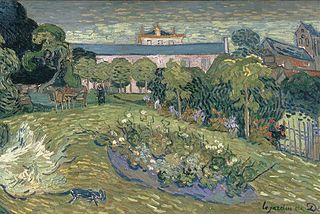
Daubigny's Garden, painted three times by Vincent van Gogh, depicts the enclosed garden of Charles-François Daubigny, a painter whom Van Gogh admired throughout his life.
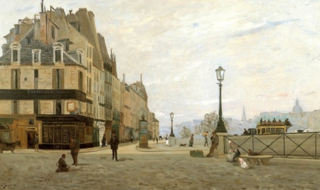
Hippolyte Camille Delpy (1842–1910) was a French painter.
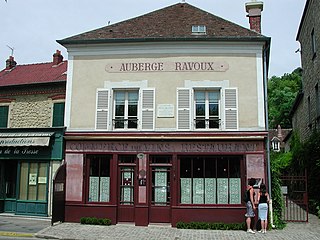
The Auberge Ravoux is a French historic landmark located in the heart of the village of Auvers-sur-Oise. It is known as the House of Van Gogh because the Dutch painter Vincent van Gogh spent the last 70 days of his life as a lodger at the auberge. During his stay at Auvers, Van Gogh created more than 80 paintings and 64 sketches before shooting himself in the chest on 27 July 1890 and dying two days later on 29 July 1890. The auberge (inn) has been restored as a museum and tourist attraction. The room where Van Gogh lived and died has been restored and can be viewed by the public.

Girl in White was painted by Vincent van Gogh in 1890 in Auvers-sur-Oise, France, during the last months of his life. Girl in White has been part of the Chester Dale Collection in the National Gallery of Art, Washington D.C. since 1963.

Dr. Gachet's Garden in Auvers and Marguerite Gachet in the Garden were both painted in 1890 by Vincent van Gogh in the gardens of his homeopathic physician, Dr. Paul Gachet. Both paintings reside at the Musée d'Orsay.

The death of Vincent van Gogh, the Dutch post-Impressionist painter, occurred in the early morning of 29 July 1890, in his room at the Auberge Ravoux in the village of Auvers-sur-Oise in northern France. Two days earlier, Van Gogh shot himself or was intentionally or accidentally shot by someone else. While his death certificate states that he died as a result of suicide, at least two biographers have challenged that, saying he may have been intentionally or accidentally shot by someone else.
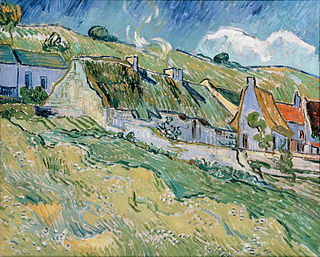
Thatched Cottages and Houses is an oil painting by Vincent van Gogh that he painted in May 1890 when he lived in Auvers-sur-Oise, France.

Old Vineyard with Peasant Woman is a watercolour painting by Vincent van Gogh that he made in May 1890 when he lived in Auvers-sur-Oise, France.

Tree Roots is an oil painting by Vincent van Gogh that he painted in July 1890 when he lived in Auvers-sur-Oise, France. The painting is an example of the double-square canvases that he employed in his last landscapes.
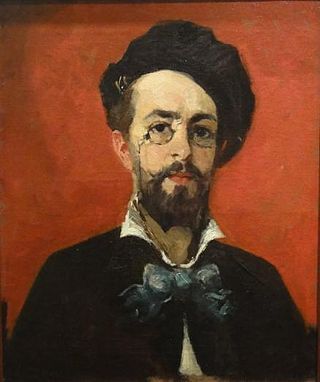
Frédéric Samuel Cordey (1854–1911) was a French landscape painter who was a part of the Impressionist movement. He was a close friend of Auguste Renoir, and had a personal fortune that allowed him to work according to his taste, regardless of the publicity and support provided by art dealers.

Houses at Auvers is an oil painting by Vincent van Gogh. It was created towards the end of May or beginning of June 1890, shortly after he had moved to Auvers-sur-Oise, a small town northwest of Paris, France.

Landscape at Auvers in the Rain is an oil on canvas painting by the Dutch Post-Impressionist painter Vincent van Gogh.

Hyacinthe-Eugène Meunier, known as Eugène Murer, was a pastry chef, author, self-taught painter and collector of impressionist paintings.

The Hanged Man's House is an 1873 oil on canvas painting by Paul Cézanne. The painting is exhibited at the Musée d'Orsay in Paris.

View of Auvers-sur-Oise is the common English name for a Paul Cézanne painting known by various French names, usually Paysage d'Auvers-sur-Oise, or in the artist's catalogue raisonné, Groupe de maisons, paysage d'île de France. It is believed to have been painted in 1879–80, several years after Cézanne's residence in Auvers-sur-Oise, a small village northwest of Paris. The painting depicts a landscape of Northern France; the exact location has not been determined.




















